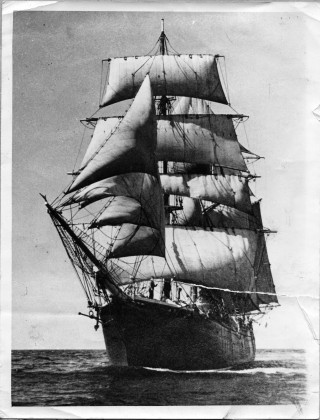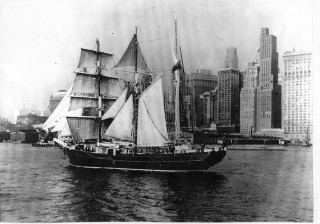The Cap Pilar
The Cap PIlar In full Sail
John Stewart
This is a photo of the old pilot vessel, the Cap Pilar, a three-masted barquentine, rescued in St.Malo on the French coast, by Adrian Seligman in 1936. She was 118 feet long, had a gross tonnage of 295 tonnes, and had been built in St Malo in 1911 as a Newfoundland cod-fishing schooner.
John Donnelly of The Folly, who, at the age of 25, was recruited by Adrian Seligman to join in his round-the-world sailing adventure, with Adrian’s newly-married wife Jane and a crew of 8 other people. The voyage would take them two years. They returned to London just before the second world war started in 1939.
This ship became famous when written up by Adrian Seligman in his book The Voyage of the Cap Pilar which was first published in 1939, and since re-published several times.
Today, her remains lie under the old dry dock in the Wivenhoe Port housing estate. She was brought upriver to Wivenhoe after the start of the war, where she stayed in a mud birth, deteriorating until she was finally manoeuvered into the dry dock in the by then derelict upstream shipyard and set afire in 1966. A sad ending to a fine sailing boat. The remains now lie under the old dry dock on the Wivenhoe Port housing estate.
This page was added on 10/04/2015.
See also this page for more pictures and details of the Cap Pilar
Picture courtesy of the Nottage Maritime Institute








Comments about this page
today i received two letters and a McCartney bottle. These were from the Ships doctor. The correspondence is about how resilient the bottle is. This is a small glass bottle with a slope of agar. It is is used in microbiology labs to this day. the bottle dates to 1936 and was given to the doctor at the East India Dock by the microbiologist who invented it. The letters give some insight into the voyage. The bottles were the only lab equipment that survived the storm in the Bay of Biscay. I am the Director of the Public Health England campus at Colindale – and the correspondence was with one of my colleagues in the late 1990s.
Add a comment about this page